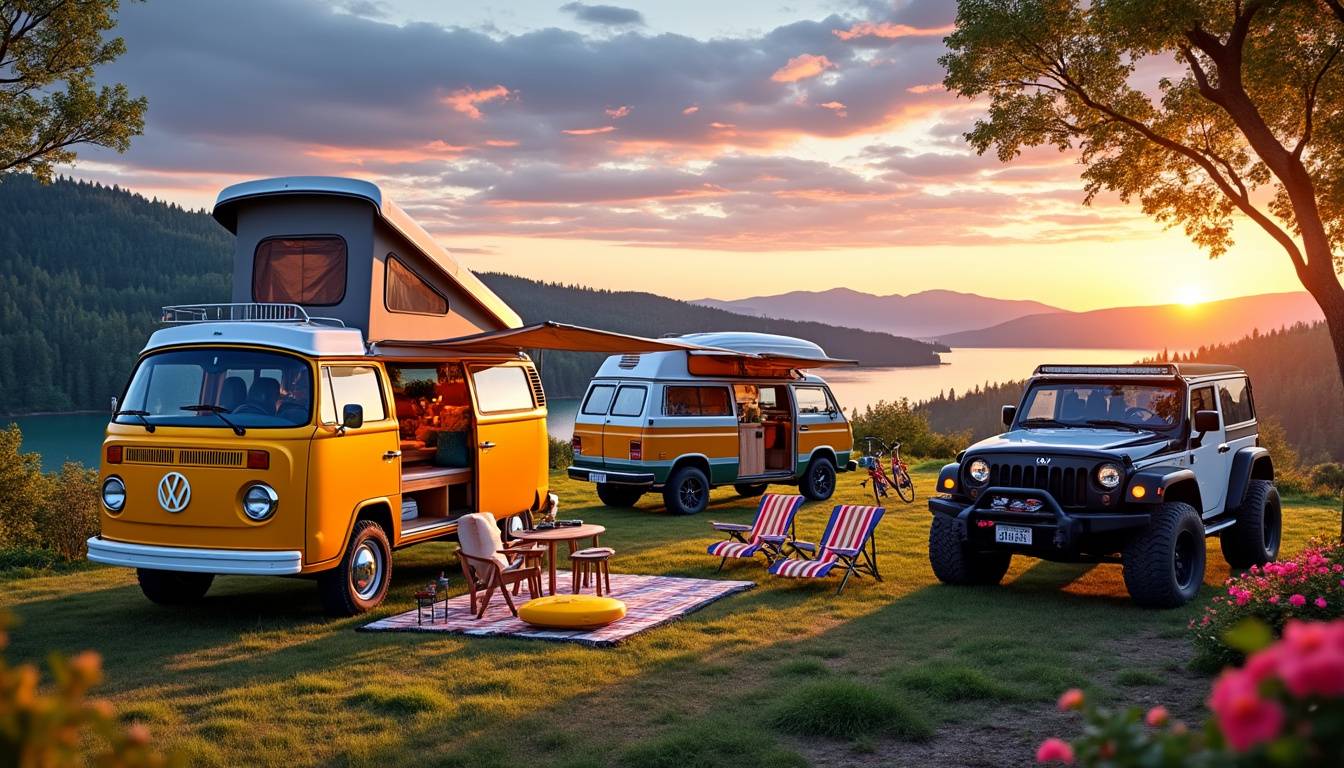Embarking on a vanlife journey embodies more than just mobility; it’s an immersive lifestyle choice that blends adventure with the comforts of a mobile home. The ever-growing appeal of living on the road is pushing travelers to carefully evaluate which vehicle best suits their wanderlust and practical needs. Whether you are venturing solo, as a couple, or with family and friends, the vehicle you choose becomes your sanctuary, your travel companion, and your mode of exploration. The market in 2025 has never been richer with options, from compact vans to spacious campers. Yet, with rising costs and varied configurations, understanding the minutiae of each choice is essential to avoid regrets and embrace freedom on wheels. This guide delves into understanding budget constraints, vehicle types, customization options, lifestyle alignment, and practical tips to select the optimal vehicle for the vanlife you envision.
Understanding your budget: a cornerstone of choosing the right vanlife vehicle
Choosing the right vehicle for your vanlife adventure begins with a clear understanding of your financial boundaries. Budget not only influences the type of vehicle you can acquire but also determines whether you aim for a brand-new model or a pre-owned one, and if you prefer a fully equipped camper or a bare utilitarian van to outfit yourself.
In 2025, the vanlife market is marked by soaring prices, particularly in the secondhand segment. Enthusiasts can expect to pay a premium as demand continues to outpace supply for popular models from manufacturers like Volkswagen, Toyota, and Ford. Even though one might instinctively think that new camping-cars are more expensive due to their size and features, this is not always a given. Sometimes a carefully chosen used van in good condition could surprisingly cost more than a brand-new compact model.
Aside from acquisition cost, budget considerations extend to ongoing expenditures such as fuel, maintenance, and insurance premiums. These costs tend to vary by vehicle type, engine size, and brand reputation. For instance, renowned names like Mercedes-Benz and RAM may command higher servicing fees but offer reliability and better performance that long-term travelers swear by.
Budgeting strategies to keep your vanlife dream viable
- Define your maximum spend: Before exploring vehicles, determine a maximum budget and stick to it, considering not just purchase price but also conversion and upkeep costs.
- Compare new vs used options: New models come with warranties and latest gear, but used vans may offer better deals at the expense of some wear and tear.
- Plan for conversion expenses: If opting for a blank utilitarian vehicle, allocation for customization must be factored, including costs for insulation, furnishings, plumbing, and electrical installations.
- Evaluate financing alternatives: Loans, leasing, or renting might be attractive options if upfront cash flow is limited.
- Research insurance premiums: Some brands and vehicle classes like Winnebago motorhomes or Airstream trailers might have different insurance requirements and rates.
| Vehicle type | Average new price (USD) | Average used price (USD) | Conversion cost range (USD) | Insurance estimate (yearly, USD) |
|---|---|---|---|---|
| Compact van (ex: VW, Toyota Hiace) | 40,000 – 60,000 | 30,000 – 50,000 | 10,000 – 25,000 | 1,200 – 1,800 |
| Medium fourgon (ex: Ford Transit, Mercedes-Benz Sprinter) | 50,000 – 80,000 | 35,000 – 65,000 | 15,000 – 35,000 | 1,800 – 2,500 |
| Full-size camping-car (ex: Winnebago, Jayco) | 70,000 – 150,000 | 50,000 – 130,000 | N/A or minimal if pre-built | 2,500 – 5,000 |
By mapping out your financial possibilities and researching model-specific expenses, you can make a well-informed purchase that aligns with both your budget and adventure goals. This financial foresight fosters a smooth transition into vanlife without unwelcome surprises.
Exploring types of vehicles for vanlife: vans, fourgons and camping-cars demystified
The choices for vanlife vehicles are mostly categorized into three main types: vans, fourgons, and camping-cars. Each has distinct characteristics, advantages, and limitations that correspond with various traveling and living styles.
Vanlife fans often find themselves debating which of these options suits their unique needs best. For solo travelers or couples who prioritize maneuverability and parking convenience, compact vans present an appealing option. Brands like Volkswagen truly epitomize versatility in this segment with models such as the iconic VW California. These vans typically boast efficient use of space with well-optimized layouts including kitchenettes, fridges, and convertible sleeping areas. Many also come with a pop-up roof extension that enhances headroom and overnight sleeping capacity.
The middle ground: fourgons as flexible multi-purpose vehicles
Fourgons, which include models like the Mercedes-Benz Sprinter and Ford Transit, represent a perfect compromise between downsized vans and large motorhomes. With lengths often starting around 5.4 meters, these vehicles provide ample living space to accommodate amenities such as indoor showers, toilets, full kitchens, and more generous sleeping arrangements. Their height generally allows standing upright inside, a big plus for comfort during extended stays. The adaptability of fourgons lets you customize the interior layout substantially, mixing comfort, practicality, and street accessibility.
The luxury and space of camping-cars
Camping-cars from manufacturers like Winnebago and Jayco are often larger and provide the kind of comfort expected from a small apartment on wheels. Their increased length and height offer more extensive living spaces, larger bathrooms, and even entertainment systems. However, their size can restrict access to narrow roads or tight parking spots, making them less ideal for spontaneous urban exploration.
- Vans: Compact dimensions, great for urban areas, less privacy.
- Fourgons: Balanced size and amenities, versatile for family use.
- Camping-cars: Spacious, well-equipped, sometimes less agile on rugged terrain.
| Vehicle type | Typical length (meters) | Height (meters) | Main amenities | Best suited for |
|---|---|---|---|---|
| Van (Volkswagen, Toyota Hiace) | 4.5 – 5.5 | 1.8 – 2.0 (with pop-top roof) | Kitchenette, fridge, convertible bed, sometimes outdoor shower | Solo travelers or couples wanting mobility and simplicity |
| Fourgon (Mercedes-Benz Sprinter, Ford Transit) | 5.4 – 7.0 | 2.0 – 2.7 | Shower, toilet, kitchen, fridge, bed, standing room | Small families, groups seeking comfort and space flexibility |
| Camping-car (Winnebago, Jayco) | 6.5 – 9.0+ | 3.0 – 3.5+ | Full bathroom, kitchen, separate sleeping quarters, living area | Extended trips or full-time living, requiring max comfort |
Selecting the right vehicle type should be guided by your intended use cases, the environments you frequent, and your expectations regarding comfort and mobility. The balance between practicality and luxury often dictates which vehicle guarantees the best experience for your vanlife journey.
Customizing your mobile home: self-conversion versus professional outfitting
One of the pivotal decisions in vanlife preparation is whether to purchase a vehicle already outfitted or to convert an empty utilitarian vehicle on your own. Each approach offers unique benefits and challenges that can significantly impact your experience and budget.
For those prioritizing cost efficiency and personal expression, a self-conversion of a purchased van or fourgon is an enriching but demanding endeavor. Converting a secondhand vehicle from scratch enables tailored layouts, choice of high-quality materials, and integration of preferred modern amenities.
Advantages and challenges of doing it yourself
- Freedom of design: Every inch can be customized to exact needs, from bed placement to storage.
- Cost savings: Avoid paying for labor, though material and tool expenses can add up.
- Learning curve: Requires skills in carpentry, electrical wiring, and plumbing.
- Time investment: Conversion may take months, requiring patience and commitment.
- Certification hurdles: Achieving VASP (specialized motor vehicle) homologation to ensure road legality can be complex and sometimes costly.
For instance, adding a pop-up roof to increase vertical space is a popular mod that can start around $5,000 and requires professional fitting to guarantee structural integrity. Likewise, VASP certification, necessary for safely transforming a vehicle into a camper recognized by law, often costs at least $500 and entails rigorous inspection processes.
Professional conversions: convenience and compliance
On the flip side, enlisting the services of a seasoned outfitter offers benefits including expertise-driven designs, adherence to regulations, and potential warranties on workmanship. Companies specializing in van conversions can tailor vehicles to clients’ preferences and ensure full compliance with safety and roadworthiness standards under different jurisdictions.
- Time efficiency: Professionals can complete conversions much faster.
- Expertise: Ensures safety, comfort, and tech integration.
- Warranty and support: Potential fixes and after-sale support.
- Higher initial cost: Typically more expensive due to labor and premium materials.
Choosing the route of self-conversion or professional assistance depends heavily on your budget, technical skills, time availability, and the look and feel you dream for your vanlife setup.
Aligning your vehicle choice with your vanlife purpose and lifestyle needs
Before locking in your vehicle decision, it is critical to analyze your motivations and intended uses for vanlife. The reasons for buying an adventure-ready vehicle vary widely: from a weekend getaway base to a full-time mobile residence.
Some enthusiasts plan to travel for brief holidays, needing compact, efficient vehicles they can park easily in urban areas and maneuver without stress. Others look for spacious fourgons or camping-cars to accommodate families, pets, or social travelers with comfort for lengthy road trips or long-term living.
Key lifestyle considerations to weigh
- Number of occupants: Solo travelers can adopt compact vans, but families may require bigger spaces with multiple beds and amenities.
- Frequency of travel: Daily use calls for durable engines and easy maintenance, while occasional trips allow more flexibility.
- Desired level of comfort: Do you need a bathroom inside or a minimalistic approach? Some prefer basic setups to stay close to nature, while others seek home-like luxuries.
- Travel terrain and destinations: For rugged terrain or mountainous regions, brands like Chevrolet and Nissan offer 4×4 equipped models that can handle rough roads.
- Storage needs: Will you carry sports equipment, bikes, or musical instruments? Space planning becomes paramount.
Introspection and honest assessment of these factors can clarify your path, save future frustration, and ensure that your mobile home is a joy to live in throughout your travels.
| Purpose | Recommended vehicle types | Benefits | Considerations |
|---|---|---|---|
| Weekend getaway or short trips | Compact van (Volkswagen, Toyota) | Easy parking, low fuel costs, maneuverable | Limited living space and facilities |
| Extended travel or family trips | Fourgon (Mercedes-Benz Sprinter, Ford Transit) | More amenities, spacious interior, standing room | Higher fuel consumption, less maneuverable |
| Full-time living or long-term stationary | Camping-car (Winnebago, Jayco) | High comfort, multiple living zones | Size constraints in cities, higher maintenance |
Essential tips, apps, and gear to enhance your vanlife adventures
Living the vanlife dream is enriched by more than just the vehicle—it’s about equipping yourself with the right tools, technology, and mindset to navigate life on wheels successfully. Here are some pro tips to guarantee your travels remain rewarding and hassle-free.
Must-have applications to simplify your journey
- Park4night: Your go-to app for locating the best camping spots, wild parking areas, and services like water and laundries across Europe and beyond.
- Homecamper: This platform connects you with locals renting out their land for camping – a unique way to immerse yourself in local culture and community.
- France Passion: With over 2,000 hosts including farmers and winemakers offering free overnight stays, it’s a cultural gem and economical choice for travelers exploring France.
- Weather apps (Windy, Meteo Blue): Vital for anticipating weather patterns, especially if your van is equipped with a pop-up roof sensitive to wind conditions.
- Gasoil Now: Helps identify the cheapest fuel stations near your location — a crucial budget-saver amid fluctuating energy prices.
- Google Maps or Waze: Classic navigation apps with real-time traffic updates and route planning.
- Mapster: A versatile tool for planning trips, marking visited locations, and saving hidden gems on your route.
Essential gear to keep onboard for a comfortable and safe trip
- Headlamps or flashlights for nighttime activities.
- Vehicle leveling tools: Cales and small spirit levels to ensure your mobile home stays flat and comfortable.
- Compact footwear like sandals or flip-flops.
- A multifunction knife for various outdoor and cooking needs.
- Durable, collapsible dishes and cups that are practical and hard to break.
- Portable picnic table and foldable chairs for outdoor relaxation.
- Clotheslines for drying; simple but effective.
- A travel journal to log memories and keep track of your journey.
When traveling with children, additional considerations come into play:
- With babies: Portable cribs and ergonomic baby carriers facilitate mobility without sacrificing comfort.
- With toddlers and older kids: Activity books, travel games like Dobble or Memory, and waterproof mats for outdoor play enhance the experience for young adventurers.
| Gear category | Examples | Purpose |
|---|---|---|
| Lighting | Headlamps, flashlights | Illumination for all activities after dark |
| Leveling | Wheel chocks, spirit levels | Ensures van is parked evenly for comfort and appliance safety |
| Kitchenware | Collapsible dishes, cutlery, cooking stove | Enables cooking and dining on the go |
| Outdoor furniture | Folding table, chairs | Extends living space outdoors |
Incorporating these apps and gear into your vanlife translates into greater convenience, safety, and enjoyment. It enables you to focus on what really matters—exploration, connection, and the thrill of life on the open road.
FAQ: choosing the perfect vehicle for your vanlife journey
- Q: What is the difference between a van and a fourgon?
A: Vans are typically more compact and easier to maneuver in crowded places, while fourgons offer more interior space, standing room, and are better suited for longer trips or family travel.
- Q: Should I opt for a new or used van?
A: New vans come with latest safety features and warranties but are more expensive. Used vans may offer budget-friendly options yet might require additional maintenance.
- Q: What does VASP homologation mean?
A: VASP is a legal certification in many countries needed to register a camper or converted vehicle. It assures that the vehicle complies with safety and technical standards for road use.
- Q: Can I do my own van conversion, or should I hire a professional?
A: DIY conversion allows great customization and potential cost savings but requires skills, time, and familiarity with legal requirements. Professional conversions offer speed, reliability, and warranties at higher initial cost.
- Q: What essential apps should I have for vanlife travel?
A: Popular apps include Park4night for campsite finding, Homecamper for local stays, France Passion for cultural stops, and Gasoil Now to find affordable fuel stations. Navigation apps like Google Maps or Waze are also important.


